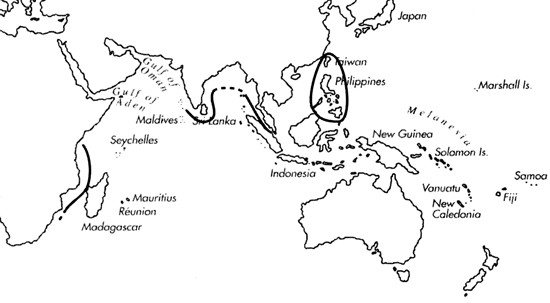
Skip Navigation Links
View access keys for this site.

Range: N. Mozambique and Tanzania, India and Sri Lanka, W. Thailand, Philippines, and Taiwan.
Description: Moderately small to medium-sized, light to moderately light. Last whorl usually narrowly conoid-cylindrical to narrowly conical; outline nearly straight, occasionally sigmoid. Shoulder angulate, to subangulate in form kantanganus (Pl. 57, Figs. 14-17), to carinate in shells from Philippines and Taiwan (Pl. 57, Figs. 18-21); exhalent notch variably deep. Spire of moderate height to high, outline slightly concave to almost straight. Larval shell of 3 or more whorls, maximum diameter 0.9-1 mm. First 5-8 postnuclear whorls distinctly tuberculate. Teleoconch sutural ramps flat, with radial threads crossing 1 broad central spiral groove in first 3-5 (sometimes to 8) whorls and 1-2 (sometimes to 3) grooves in following whorls; sutures deep and wide. Last whorl with regularly spaced, axially striate spiral grooves and ribbons or occasionally ribs between; surface sculpture less prominent in E. African shells.
| Shell Morphometry | ||
|---|---|---|
| L | 29-46 mm | |
| (- 36 mm form kantanganus) | ||
| RW | 0.03-0.10 g/mm | |
| RD | 0.39-0.45 | |
| (- 0.48 Philippines, Taiwan) | ||
| PMD | 0.83-0.90 | |
| RSH | 0.19-0.30 | |
Ground colour white (shells from Mozambique) to beige (shells from India to Taiwan). Last whorl with spiral rows of regular or irregular brown dots or rectangular spots on ribbons and ribs, partly fusing into irregularly sized axial flecks and streaks that cluster into spiral bands above and below centre; a weaker spiral band sometimes present below shoulder. Pattern of shells from Mozambique often reduced to axial streaks of both sides of centre and below shoulder. Larval whorls grey, also brown in shells from Philippines and Taiwan. Teleoconch spire matching last whorl in pattern. Aperture translucent.
Periostracum greyish brown, thin, translucent.
Animals from Mozambique yellow, mottled with black. Operculum absent.
The species has a very small radula, only about 0.01 as long as the shell (Ramalho, pers. comm., 1989).
Habitat and Habits: Subtidal fringe, buried in sand, 1-2.5 cm below surface in habitats sheltered from heavy wave action. The animals emerge and crawl toward shore on the incoming tide (Mozambique; Grosch, pers. comm., 1989). Empty shells in 50 and 75 m off Tranquebar, India (Kohn, 1978). Shells from W. Thailand in 20-50 m, those from Philippines and Taiwan on silty sand bottoms in 30-55 m.
Discussion: C. longurionis resembles C. aculeiformis, C. vimineus, C. hopwoodi, and C. elegans. C. aculeiformis has a lower, concave-sided rather than straight-sided spire (RSH 0.17-0.22) and lacks tubercles on the postnuclear whorls; its last whorl is more conical (PMD 0.86-0.95), and the spiral grooves on its teleoconch sutural ramps are differently arranged. C. vimineus has a broader larval shell (1.1-1.2 mm) with 4.0-4.5 whorls separated by deep and wide sutures; its spire is generally lower (RSH 0.15-0.25) and has a slightly concave to sigmoid rather than straight outline; the early teleoconch sutural ramps have 3 spiral grooves, and the spire whorls lack tubercles. For comparison with C. hopwoodi and C. elegans, see the Discussions of those species. Shells from India and W. Thailand (Pl. 57, Figs. 14-17) were described as C. kantanganus, while the original figure of C. longurionis refers to E. African shells (Pl. 57, Figs. 9-13). C. kantanganus and the similar shells from Taiwan and Philippines (Pl. 57, Figs. 18-21) cannot be separated from C. longurionis at the species level and are considered geographical forms.

C. longurionis range map
This section contains verbatim reproductions of the accounts of 316 species of Conus from the Indo-Pacific region, from Manual of the Living Conidae, by Röckel, Korn and Kohn (1995). They are reproduced with the kind permission of the present publisher, Conchbooks.
All plates and figures referred to in the text are also in Röckel, Korn & Kohn, 1995. Manual of the Living Conidae Vol. 1: Indo-Pacific Region.
The range maps have been modified so that each species account has it own map, rather than one map that showed the ranges of several species in the original work. This was necessary because each species account is on a separate page on the website and not confined to the order of accounts in the book.
Return to framed version (returns to search page)